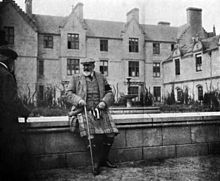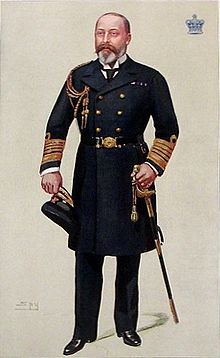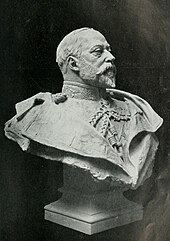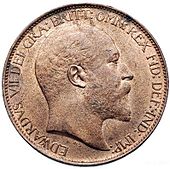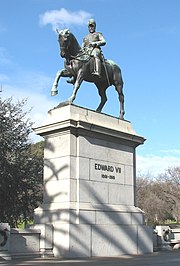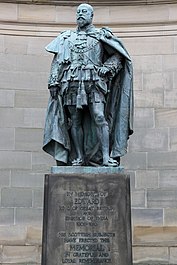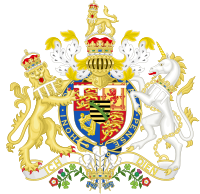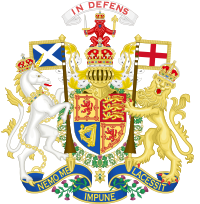cure for cancer: 1907 https://en.wikipedia.org/wiki/Radium
Edward VII
From Wikipedia, the free encyclopedia
For other uses, see Edward VII (disambiguation).
| Edward VII | |||||
|---|---|---|---|---|---|
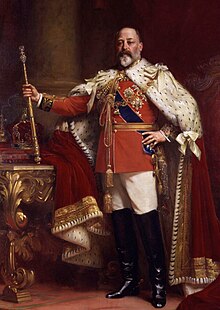
Coronation portrait by Sir Luke Fildes
| |||||
| King of the United Kingdom and the British Dominions, Emperor of India (more...) | |||||
| Reign | 22 January 1901 – 6 May 1910 | ||||
| Coronation | 9 August 1902 | ||||
| Imperial Durbar | 1 January 1903 | ||||
| Predecessor | Victoria | ||||
| Successor | George V | ||||
| Prime Ministers | See list | ||||
| Born | 9 November 1841 Buckingham Palace, London | ||||
| Died | 6 May 1910 (aged 68) Buckingham Palace, London | ||||
| Burial | 20 May 1910 St George's Chapel, Windsor Castle, Windsor, Berkshire | ||||
| Spouse | Alexandra of Denmark (m. 1863) | ||||
| Issue Detail | Prince Albert Victor, Duke of Clarence and Avondale George V Louise, Princess Royal Princess Victoria Maud, Queen of Norway Prince Alexander John of Wales | ||||
| |||||
| House | Saxe-Coburg and Gotha | ||||
| Father | Albert, Prince Consort | ||||
| Mother | Queen Victoria | ||||
| Religion | Anglican | ||||
| Signature | |||||
Edward VII (Albert Edward; 9 November 1841 – 6 May 1910) was King of the United Kingdom and the British Dominions andEmperor of India from 22 January 1901 until his death in 1910.
The eldest son of Queen Victoria and Prince Albert of Saxe-Coburg and Gotha, Edward was related to royalty throughout Europe. Before his accession to the throne, he served as heir apparent and held the title of Prince of Wales for longer than any of his predecessors. During the long reign of his mother, he was largely excluded from political power, and came to personify the fashionable, leisured elite. He travelled throughout Britain performing ceremonial public duties, and represented Britain on visits abroad. His tours of North America in 1860 and the Indian subcontinent in 1875 were popular successes, but despite public approval his reputation as a playboy prince soured his relationship with his mother.
As king, Edward played a role in the modernisation of the British Home Fleet and the reorganisation of the British Army after theSecond Boer War. He re-instituted traditional ceremonies as public displays and broadened the range of people with whom royalty socialised. He fostered good relations between Britain and other European countries, especially France, for which he was popularly called "Peacemaker", but his relationship with his nephew, Kaiser Wilhelm II, was poor. The Edwardian era, which covered Edward's reign and was named after him, coincided with the start of a new century and heralded significant changes in technology and society, including steam turbine propulsion and the rise of socialism. He died in 1910 in the midst of a constitutional crisis that was resolved the following year by the Parliament Act 1911, which restricted the power of the unelected House of Lords.
Contents
[hide]Early life and education[edit]
Edward was born at 10:48 in the morning on 9 November 1841 in Buckingham Palace.[1] He was the eldest son and second child of Queen Victoria and her husband (and first cousin) Prince Albert of Saxe-Coburg and Gotha. He was christened Albert Edward at St George's Chapel, Windsor Castle, on 25 January 1842.[a] He was named Albert after his father and Edward after his maternal grandfather Prince Edward, Duke of Kent and Strathearn. He was known as Bertie to the royal family throughout his life.[3]
As the eldest son of the British sovereign, he was automatically Duke of Cornwall and Duke of Rothesay at birth. As a son of Prince Albert, he also held the titles of Prince of Saxe-Coburg and Gotha and Duke of Saxony. He was created Prince of Wales and Earl of Chester on 8 December 1841, Earl of Dublin on 17 January 1850, a Knight of the Garter on 9 November 1858, and a Knight of the Thistle on 24 May 1867.[4] In 1863, he renounced his succession rights to the Duchy of Saxe-Coburg and Gotha in favour of his younger brother, Prince Alfred.[5]
Queen Victoria and Prince Albert were determined that their eldest son should have an education that would prepare him to be a modelconstitutional monarch. At age seven, Edward embarked on a rigorous educational programme devised by Prince Albert, and supervised by several tutors. Unlike his elder sister Victoria, Edward did not excel in his studies.[6] He tried to meet the expectations of his parents, but to no avail. Although Edward was not a diligent student—his true talents were those of charm, sociability and tact—Benjamin Disraeli described him as informed, intelligent and of sweet manner.[7] After the completion of his secondary-level studies, his tutor was replaced by a personal governor, Robert Bruce.
After an educational trip to Rome, undertaken in the first few months of 1859, he spent the summer of that year studying at the University of Edinburgh under, amongst others, the chemist Lyon Playfair. In October, he matriculated as an undergraduate at Christ Church, Oxford.[8] Now released from the educational strictures imposed by his parents, he enjoyed studying for the first time and performed satisfactorily in examinations.[9] In 1861, he transferred to Trinity College, Cambridge,[10] where he was tutored in history byCharles Kingsley, Regius Professor of Modern History.[11] Kingsley's efforts brought forth the best academic performances of Edward's life, and Edward actually looked forward to his lectures.[12]
Early adulthood[edit]
In 1860, Edward undertook the first tour of North America by an heir to the British throne. His genial good humour and confident bonhomiemade the tour a great success.[13] He inaugurated the Victoria Bridge, Montreal, across the St Lawrence River, and laid the cornerstone ofParliament Hill, Ottawa. He watched Charles Blondin traverse Niagara Falls by highwire, and stayed for three days with President James Buchanan at the White House. Buchanan accompanied the Prince to Mount Vernon, to pay his respects at the tomb of George Washington. Vast crowds greeted him everywhere. He met Henry Wadsworth Longfellow, Ralph Waldo Emerson and Oliver Wendell Holmes. Prayers for the royal family were said in Trinity Church, New York, for the first time since 1776.[13] The four-month tour throughout Canada and the United States considerably boosted Edward's confidence and self-esteem, and had many diplomatic benefits for Great Britain.[14]
Edward had hoped to pursue a career in the British Army, but his mother vetoed an active military career.[15] He had been gazetted colonel on 9 November 1858[16]—to his disappointment, as he had wanted to earn his commission by examination.[9] In September 1861, Edward was sent to Germany, supposedly to watch military manoeuvres, but actually in order to engineer a meeting between him and Princess Alexandra of Denmark, the eldest daughter of Prince Christian of Denmark and his wife Louise. Queen Victoria and Prince Albert had already decided that Edward and Alexandra should marry. They met at Speyer on 24 September under the auspices of his elder sister, Victoria, who had married the Crown Prince of Prussia in 1858.[17] Edward's elder sister, acting upon instructions from their mother, had met Princess Alexandra at Strelitz in June; the young Danish princess made a very favourable impression. Edward and Alexandra were friendly from the start; the meeting went well for both sides, and marriage plans advanced.[18]
From this time, Edward gained a reputation as a playboy. Determined to get some army experience, Edward attended manoeuvres in Ireland, during which he spent three nights with an actress, Nellie Clifden, who was hidden in the camp by his fellow officers.[19] Prince Albert, though ill, was appalled and visited Edward at Cambridge to issue a reprimand. Albert died in December 1861 just two weeks after the visit. Queen Victoria was inconsolable, wore mourning clothes for the rest of her life and blamed Edward for his father's death.[20] At first, she regarded her son with distaste as frivolous, indiscreet and irresponsible. She wrote to her eldest daughter, "I never can, or shall, look at him without a shudder."[21]
Marriage[edit]
Once widowed, Queen Victoria effectively withdrew from public life. Shortly after Prince Albert's death, she arranged for Edward to embark on an extensive tour of the Middle East, visiting Egypt, Jerusalem, Damascus, Beirut and Constantinople.[22] The British Government wanted Edward to secure the friendship of Egypt's ruler, Said Pasha, to prevent French control of the Suez Canal if the Ottoman Empire collapsed. It was the first royal tour on which an official photographer, Francis Bedford, was in attendance.[23] As soon as Edward returned to Britain, preparations were made for his engagement, which was sealed at Laeken in Belgium on 9 September 1862.[24] Edward married Alexandra at St George's Chapel, Windsor Castle, on 10 March 1863. He was 21; she was 18.
The couple established Marlborough House as their London residence and Sandringham House in Norfolk as their country retreat. They entertained on a lavish scale. Their marriage met with disapproval in certain circles because most of Queen Victoria's relations were German, and Denmark was at loggerheads with Germany over the territories of Schleswig and Holstein. When Alexandra's father inherited the throne of Denmark in November 1863, the German Confederation took the opportunity to invade and annex Schleswig-Holstein. Queen Victoria was of two minds whether it was a suitable match given the political climate.[25] After the marriage, she expressed anxiety about their socialite lifestyle and attempted to dictate to them on various matters, including the names of their children.[26]
Edward had mistresses throughout his married life. He socialised with actress Lillie Langtry; Lady Randolph Churchill (born Jennie Jerome, she was the mother of Winston Churchill);[b] Daisy Greville, Countess of Warwick; actress Sarah Bernhardt; noblewoman Lady Susan Vane-Tempest; singer Hortense Schneider; prostitute Giulia Beneni (known as "La Barucci"); wealthy humanitarian Agnes Keyser; and Alice Keppel. At least fifty-five liaisons are conjectured.[28] How far these relationships went is not always clear. Edward always strove to be discreet, but this did not prevent society gossip or press speculation.[29] One of Alice Keppel's great-granddaughters, Camilla Parker Bowles, became the mistress and subsequently wife of Charles, Prince of Wales, one of Edward's great-great-grandsons. It was rumoured that Camilla's grandmother, Sonia Keppel (born in May 1900), was the illegitimate daughter of Edward, but she was "almost certainly" the daughter of George Keppel, whom she resembled.[30] Edward never acknowledged any illegitimate children.[31] Alexandra is believed to have been aware of many of his affairs and to have accepted them.[32]
In 1869, Sir Charles Mordaunt, a British Member of Parliament, threatened to name Edward as co-respondent in his divorce suit. Ultimately, he did not do so but Edward was called as a witness in the case in early 1870. It was shown that Edward had visited the Mordaunts' house while Sir Charles was away sitting in the House of Commons. Although nothing further was proven and Edward denied he had committed adultery, the suggestion of impropriety was damaging.[9][33]
In the 1880s, Edward was a regular habitué of Parisian brothels, most notably Le Chabanais, which was regarded as the top establishment in Paris where brothels were legal. One room contained a custom made bath which was sometimes filled with champagne; and a specially designed and crafted siège d'amour (love seat) that allowed easy access for oral and other forms of sex for two or three people. It is now a museum piece.[34][35][36]
Heir apparent[edit]
During Queen Victoria's widowhood, Edward pioneered the idea of royal public appearances as we understand them today—for example, opening Thames Embankment in 1871,Mersey Tunnel in 1886, and Tower Bridge in 1894[37]—but his mother did not allow Edward an active role in the running of the country until 1898.[38][39] He was sent summaries of important government documents, but she refused to give him access to the originals.[9] He annoyed his mother by siding with Denmark on the Schleswig-Holstein Question in 1864 (she was pro-German) and in the same year annoyed her again by making a special effort to meet Giuseppe Garibaldi.[40] Liberal Prime Minister William Ewart Gladstonesent him papers secretly.[9] From 1886, Foreign Secretary Lord Rosebery sent him Foreign Office despatches, and from 1892 some Cabinet papers were opened to him.[9]
In 1870 republican sentiment in Britain was given a boost when the French Emperor, Napoleon III, was defeated in the Franco-Prussian War and the French Third Republic was declared.[41] However, in the winter of 1871, a brush with death led to an improvement in both Edward's popularity with the public and his relationship with his mother. While staying at Londesborough Lodge, near Scarborough, North Yorkshire, Edward contracted typhoid, the disease that was believed to have killed his father. There was great national concern, and one of his fellow guests (Lord Chesterfield) died. Edward's recovery was greeted with almost universal relief.[9] Public celebrations included the composition of Arthur Sullivan's Festival Te Deum. Edward cultivated politicians from all parties, including republicans, as his friends, and thereby largely dissipated any residual feelings against him.[42]
In October 1875 Edward set off for India on an extensive eight-month tour of the sub-continent. His advisors remarked on his habit of treating all people the same, regardless of their social station or colour. In letters home, he complained of the treatment of the native Indians by the British officials: "Because a man has a black face and a different religion from our own, there is no reason why he should be treated as a brute."[43] Consequently, Lord Salisbury, the Secretary of State for India, issued new guidance and at least one resident was removed from office.[9] At the end of the tour, Queen Victoria was given the title Empress of India by Parliament, in part as a result of the tour's success.[44]
He was regarded worldwide as an arbiter of men's fashions.[45][46] He made wearing tweed, Homburg hats and Norfolk jacketsfashionable, and popularised the wearing of black ties with dinner jackets, instead of white tie and tails.[47] He pioneered the pressing of trouser legs from side to side in preference to the now normal front and back creases,[48] and was thought to have introduced the stand-up turn-down shirt collar.[49] A stickler for proper dress, he is said to have admonished Lord Salisbury for wearing the trousers of an Elder Brother of Trinity House with a Privy Councillor's coat. Deep in an international crisis, Salisbury informed the Prince that it had been a dark morning, and that "my mind must have been occupied by some subject of less importance."[50] The tradition of men not buttoning the bottom button of waistcoats is said to be linked to Edward, who supposedly left his undone because of his large girth.[9][51] His waist measured 48 inches (122 cm) shortly before his coronation.[52] He introduced the practice of eating roast beef, roast potatoes, horseradish sauce and yorkshire pudding on Sundays, which remains a staple British favourite for Sunday lunch.[53][c]
Edward was a patron of the arts and sciences and helped found the Royal College of Music. He opened the college in 1883 with the words, "Class can no longer stand apart from class ... I claim for music that it produces that union of feeling which I much desire to promote."[44] At the same time, he enjoyed gambling and country sports and was an enthusiastic hunter. He ordered all the clocks at Sandringham to run half an hour ahead to provide more daylight time for shooting. This so-called tradition of Sandringham Time continued until 1936, when it was abolished by Edward VIII.[55] He also laid out a golf course at Windsor. By the 1870s the future king had taken a keen interest in horseracing and steeplechasing. In 1896, his horse Persimmon won both the Derby Stakes and the St Leger Stakes. In 1900, Persimmon's brother,Diamond Jubilee, won five races (Derby, St Leger, 2,000 Guineas Stakes, Newmarket Stakes and Eclipse Stakes)[56] and another of Edward's horses, Ambush II, won the Grand National.[57]
In 1891 Edward was embroiled in the royal baccarat scandal, when it was revealed he had played an illegal card game for money the previous year. The Prince was forced to appear as a witness in court for a second time when one of the participants unsuccessfully sued his fellow players for slander after being accused of cheating.[58] In the same year Edward was involved in a personal conflict, when Lord Charles Beresford threatened to reveal details of Edward's private life to the press, as a protest against Edward interfering with Beresford's affair with Daisy Greville, Countess of Warwick. The friendship between the two men was irreversibly damaged and their bitterness would last for the remainder of their lives.[59] Usually, Edward's outbursts of temper were short-lived, and "after he had let himself go ... [he would] smooth matters by being especially nice".[60]
In late 1891 Edward's eldest son, Albert Victor, was engaged to Princess Victoria Mary of Teck. Just a few weeks later, in early 1892, Albert Victor died of pneumonia. Edward was grief-stricken. "To lose our eldest son", he wrote, "is one of those calamities one can never really get over". Edward told Queen Victoria, "[I would] have given my life for him, as I put no value on mine".[61] Albert Victor was the second of Edward's children to die. In 1871, his youngest son, Alexander John, had died just 24 hours after being born. Edward had insisted on placing Alexander John in a coffin personally with "the tears rolling down his cheeks".[62]
On his way to Denmark through Belgium on 4 April 1900 Edward was the victim of an attempted assassination, when fifteen-year-oldJean-Baptiste Sipido shot at him in protest over the Boer War. Sipido, though obviously guilty, was acquitted by a Belgian court because he was underage.[63] The perceived laxity of the Belgian authorities, combined with British disgust at Belgian atrocities in the Congo, worsened the already poor relations between the United Kingdom and the Continent. However, in the next ten years, Edward's affability and popularity, as well as his use of family connections, assisted Britain in building European alliances.[64]
Accession[edit]
When Queen Victoria died on 22 January 1901, Edward became King of the United Kingdom, Emperor of India and, in an innovation, King of the British Dominions.[65] He chose to reign under the name Edward VII, instead of Albert Edward—the name his mother had intended for him to use[d]—declaring that he did not wish to "undervalue the name of Albert" and diminish the status of his father with whom the "name should stand alone".[66] The numeral VII was occasionally omitted in Scotland, even by the national church, in deference to protests that the previous Edwards were English kings who had "been excluded from Scotland by battle".[9] J. B. Priestley recalled, "I was only a child when he succeeded Victoria in 1901, but I can testify to his extraordinary popularity. He was in fact the most popular king England had known since the earlier 1660s."[67]
He donated his parents' house, Osborne on the Isle of Wight, to the state and continued to live at Sandringham.[68] He could afford to be magnanimous; his private secretary, Sir Francis Knollys, claimed that he was the first heir to succeed to the throne in credit.[69] Edward's finances had been ably managed by Sir Dighton Probyn, Comptroller of the Household, and had benefited from advice from Edward's Jewish financier friends, such as Ernest Cassel, Maurice de Hirsch and the Rothschild family.[70] At a time of widespread anti-Semitism, Edward attracted criticism for openly socialising with Jews.[71][72]
Edward's coronation had originally been scheduled for 26 June, but two days before on 24 June, he was diagnosed with appendicitis.[73]Appendicitis was generally not treated operatively and carried a high mortality rate, but developments in anaesthesia and antisepsis in the preceding 50 years made life-saving surgery possible.[74] Sir Frederick Treves, with the support of Lord Lister, performed a then-radical operation of draining a pint of pus from the infected abscess through a small incision (through 4½ inch thickness of belly fat and abdomen wall); this outcome showed thankfully that the cause was not cancer.[75] The next day, Edward was sitting up in bed, smoking a cigar.[76] Two weeks later, it was announced that the King was out of danger. Treves was honoured with a baronetcy (which Edward had arranged before the operation)[77]and appendix surgery entered the medical mainstream.[74] Edward was crowned at Westminster Abbey on 9 August 1902 by the 80-year-oldArchbishop of Canterbury, Frederick Temple, who died only four months later.[73]
Edward refurbished the royal palaces, reintroduced the traditional ceremonies, such as the State Opening of Parliament, that his mother had forgone, and founded new honours, such as the Order of Merit, to recognise contributions to the arts and sciences.[78] In 1902, the Shah of Persia, Mozzafar-al-Din, visited England expecting to receive the Order of the Garter. Edward refused to bestow the honour on the Shah because the order was meant to be in his personal gift and the Foreign Secretary, Lord Lansdowne, had promised it without his consent. Edward also objected to inducting a Muslim into a Christian order of chivalry. His refusal threatened to damage British attempts to gain influence in Persia,[79] but Edward resented his ministers' attempts to reduce the King's traditional powers.[80] Eventually, he relented and Britain sent a special embassy to the Shah with a full Order of the Garter the following year.[81]
"Uncle of Europe"[edit]
As king, Edward's main interests lay in the fields of foreign affairs and naval and military matters. Fluent in French and German, he made a number of visits abroad, and took annual holidays in Biarritz and Marienbad.[55] One of his most important foreign trips was an official visit to France in May 1903 as the guest of President Émile Loubet. Following a visit to the Pope in Rome, this trip helped create the atmosphere for the Anglo-French Entente Cordiale, an agreement delineating British and French colonies in North Africa, and ruling out any future war between the two countries. The Entente was negotiated between the French foreign minister, Théophile Delcassé, and the British foreign secretary, Lord Lansdowne. Signed in London on 8 April 1904 by Lansdowne and the French ambassador Paul Cambon, it marked the end of centuries of Anglo-French rivalry and Britain's splendid isolation from Continental affairs, and attempted to counterbalance the growing dominance of the German Empire and its ally, Austria-Hungary.[82]
Edward was related to nearly every other European monarch and came to be known as the "uncle of Europe".[38] Kaiser Wilhelm II was his nephew; Tsar Nicholas II was his nephew-by-marriage; Queen Victoria Eugenia of Spain, Crown Princess Margaret of Sweden, Crown Princess Marie of Romania, Crown Princess Sophia of Greece, and Empress Alexandra of Russia were his nieces; Haakon VII of Norwaywas both his nephew by marriage and his son-in-law; Frederick VIII of Denmark and George I of Greece were his brothers-in-law; Albert I of Belgium, Ferdinand of Bulgaria, and Charles I and Manuel II of Portugal were his second cousins. Edward doted on his grandchildren, and indulged them, to the consternation of their governesses.[83] However, there was one relation whom Edward did not like: Wilhelm II. Edward's difficult relationship with his nephew exacerbated the tensions between Germany and Britain.[84]
In April 1908, during Edward's annual stay at Biarritz, he accepted the resignation of British Prime Minister Sir Henry Campbell-Bannerman. In a break with precedent, Edward asked Campbell-Bannerman's successor, H. H. Asquith, to travel to Biarritz to kiss hands. Asquith complied, but the press criticised the action of the King in appointing a prime minister on foreign soil instead of returning to Britain.[85] In June 1908, Edward became the first reigning British monarch to visit the Russian Empire, despite refusing to visit in 1906, when Anglo-Russian relations were strained in the aftermath of the Russo-Japanese War, the Dogger Bank incident, and the Tsar's dissolution of the Duma.[86] The previous month, Edward visited the Scandinavian countries, becoming the first British monarch to visit Sweden.[87]
Political opinions[edit]
While Prince of Wales, Edward had to be dissuaded from breaking with constitutional precedent by openly voting for Gladstone'sRepresentation of the People Bill (1884) in the House of Lords.[9][88] On other matters he was less progressive: he did not, for example, favour giving votes to women,[9][89] although he did suggest that the social reformer Octavia Hill serve on the Commission for Working Class Housing.[90] He was also opposed to Irish Home Rule, instead preferring a form of dual monarchy.[9]
As Prince of Wales, he had come to enjoy warm and mutually respectful relations with W. E. Gladstone, whom his mother detested.[91] But Gladstone's son, Home Secretary Herbert Gladstone, angered the King by planning to permit Roman Catholic priests in vestments to carry the Host through the streets of London, and by appointing two ladies, Lady Frances Balfour and Mrs H. J. Tennant, to serve on a Royal Commission on reforming divorce law – Edward thought divorce could not be discussed with "delicacy or even decency" before ladies. Edward's biographer Philip Magnus suggests that Gladstone may have become a whipping-boy for the King's general irritation with the Liberal government. Gladstone was sacked in the reshuffle the following year and the King agreed, with some reluctance, to appoint him Governor-General of South Africa.[92]
Edward involved himself heavily in discussions over army reform, the need for which had become apparent with the failings of the Boer War.[93] He supported the redesign of army command, the creation of the Territorial Force, and the decision to provide an Expeditionary Force supporting France in the event of war with Germany.[94] Reform of the Royal Navy was also suggested, partly due to the ever-increasing Naval Estimates, and because of the emergence of the Imperial German Navy as a new strategic threat.[95] Ultimately a dispute arose between Admiral Lord Charles Beresford, who favoured increased spending and a broad deployment, and the First Sea LordAdmiral Sir John Fisher, who favoured efficiency savings, scrapping obsolete vessels, and a strategic realignment of the Royal Navy relying on torpedo craft for home defence backed by the new dreadnoughts.[96]
The King lent support to Fisher, in part because he disliked Beresford, and eventually Beresford was dismissed. Beresford continued his campaign outside of the navy and Fisher ultimately announced his resignation in late 1909, although the bulk of his policies were retained.[97] The King was intimately involved in the appointment of Fisher's successor as the Fisher-Beresford feud had split the service, and the only truly qualified figure known to be outside of both camps was Sir Arthur Knyvet Wilson, who had retired in 1907.[98] Wilson was reluctant to return to active duty, but Edward persuaded him to do so, and Wilson became First Sea Lord on 25 January 1910.[99]
Edward was rarely interested in politics, although his views on some issues were notably liberal for the time. During his reign he said use of the word nigger was "disgraceful" despite it then being in common parlance.[100] In 1904, during an Anglo-German summit in Kiel between Wilhelm II and Edward, Wilhelm with the Russo-Japanese War in mind started to go on about the "Yellow Peril", which he called "the greatest peril menacing ... Christendom and European civilisation. If the Russians went on giving ground, the yellow race would, in twenty years time, be in Moscow and Posen".[101] Wilhelm went on to attack his British guests for supporting Japan against Russia, suggesting that the British were committing "race treason". In response, Edward stated that he "could not see it. The Japanese were an intelligent, brave and chivalrous nation, quite as civilised as the Europeans, from whom they only differed by the pigmentation of their skin".[101]
Edward lived a life of luxury that was often far removed from that of the majority of his subjects. However, his personal charm with people at all levels of society and his strong condemnation of prejudice went some way to assuage republican and racial tensions building during his lifetime.[9]
Constitutional crisis[edit]
In the last year of his life, Edward became embroiled in a constitutional crisis when the Conservative majority in the House of Lords refused to pass the "People's Budget" proposed by the Liberal government of Prime Minister H. H. Asquith. The crisis eventually led – after Edward's death – to the removal of the Lords' right to veto legislation.
The King was displeased at Liberal attacks on the peers, which included a polemical speech by David Lloyd George at Limehouse.[102] Cabinet minister Winston Churchill publicly demanded a general election, for which Asquith apologised to the King's adviser Lord Knollys and rebuked Churchill at a Cabinet meeting. Edward was so depressed at the tone of class warfare – although Asquith told him that party rancour had been just as bad over the First Home Rule Bill in 1886 – that he introduced his son to Secretary of State for War Richard Haldane as "the last King of England".[103] After the King's horse Minoru won the Derby on 26 July 1909, he returned to the racetrack the following day, and laughed when a man shouted: "Now, King. You've won the Derby. Go back home and dissolve this bloody Parliament!"[104]
In vain, the King urged Conservative leaders Arthur Balfour and Lord Lansdowne to pass the Budget, which Lord Esher had advised him was not unusual, as Queen Victoria had helped to broker agreements between the two Houses over Irish disestablishment in 1869 and the Third Reform Act in 1884.[105] On Asquith's advice, however, he did not offer them an election (at which, to judge from recent by-elections, they were likely to gain seats) as a reward for doing so.[106]
The Finance Bill passed the Commons on 5 November 1909 but was rejected by the Lords on 30 November; they instead passed a resolution of Lord Lansdowne's stating that they were entitled to oppose the bill as it lacked an electoral mandate. The King was annoyed that his efforts to urge passage of the budget had become public knowledge[107] and had forbidden his adviser Lord Knollys, who was an active Liberal peer, from voting for the budget, although Knollys had suggested that this would be a suitable gesture to indicate royal desire to see the Budget pass.[108] In December 1909, a proposal to create peers (to give the Liberals a majority in the Lords) or give the prime minister the right to do so was considered "outrageous" by Knollys, who thought the King should abdicate rather than agree to it.[109]
The January 1910 election was dominated by talk of removing the Lords' veto. During the election campaign Lloyd George talked of "guarantees" and Asquith of "safeguards" that would be necessary before forming another Liberal government, but the King informed Asquith that he would not be willing to contemplate creating peers until after a second general election.[9][110] Balfour refused to be drawn on whether or not he would be willing to form a Conservative government, but advised the King not to promise to create peers until he had seen the terms of any proposed constitutional change.[111] During the campaign the leading Conservative Walter Long had asked Knollys for permission to state that the King did not favour Irish Home Rule, but Knollys refused on the grounds that it was not appropriate for the monarch's views to be known in public.[112]
The election resulted in a hung parliament, with the Liberal government dependent on the support of the third largest party, the Irish nationalists. The King suggested a compromise whereby only 50 peers from each side would be allowed to vote, which would also redress the large Conservative majority in the Lords, but Lord Crewe, Liberal leader in the Lords, advised that this would reduce the Lords' independence as only peers who were loyal party supporters would be picked.[112] Pressure to remove the Lords' veto now came from the Irish nationalist MPs, who wanted to remove the Lords' ability to block the introduction of Irish Home Rule. They threatened to vote against the Budget unless they had their way (an attempt by Lloyd George to win their support by amending whisky duties was abandoned as the Cabinet felt this would recast the Budget too much). Asquith now revealed that there were no "guarantees" for the creation of peers. The Cabinet considered resigning and leaving it up to Balfour to try to form a Conservative government.[113]
The King's Speech from the Throne on 21 February made reference to introducing measures restricting the Lords' power of veto to one of delay, but Asquith inserted a phrase "in the opinion of my advisers" so the King could be seen to be distancing himself from the planned legislation.[114]
The Commons passed resolutions on 14 April that would form the basis for the Parliament Act: to remove the power of the Lords to veto money bills, to replace their veto of other bills with a power to delay, and to reduce the term of Parliament from seven years to five (the King would have preferred four[111]). But in that debate Asquith hinted – to ensure the support of the nationalist MPs – that he would ask the King to break the deadlock "in that Parliament" (i.e. contrary to Edward's earlier stipulation that there be a second election). The Budget was passed by both Commons and Lords in April.[115]
By April the Palace was having secret talks with Balfour and the Archbishop of Canterbury, who both advised that the Liberals did not have sufficient mandate to demand the creation of peers. The King thought the whole proposal "simply disgusting" and that the government was "in the hands of Redmond & Co". Lord Crewe announced publicly that the government's wish to create peers should be treated as formal "ministerial advice" (which, by convention, the monarch must obey) although Lord Esher argued that the monarch was entitled in extremis to dismiss the government rather than take their "advice".[116] Esher's view has been called "obsolete and unhelpful".[117]
Death[edit]
Edward habitually smoked twenty cigarettes and twelve cigars a day. In 1907, a rodent ulcer, a type of cancer affecting the skin next to his nose, was cured with radium.[118] Towards the end of his life he increasingly suffered from bronchitis.[9] He suffered a momentary loss of consciousness during a state visit to Berlin in February 1909.[119] In March 1910, he was staying at Biarritz when he collapsed. He remained there to convalesce, while in London Asquith tried to get the Finance Bill passed. The King's continued ill health was unreported and he attracted criticism for staying in France while political tensions were so high.[9] On 27 April he returned to Buckingham Palace, still suffering from severe bronchitis. Alexandra returned from visiting her brother, King George I of Greece, in Corfu a week later on 5 May.
The following day, the King suffered several heart attacks, but refused to go to bed, saying, "No, I shall not give in; I shall go on; I shall work to the end."[120] Between moments of faintness, his son the Prince of Wales (shortly to be King George V) told him that his horse, Witch of the Air, had won at Kempton Park that afternoon. The King replied, "Yes, I have heard of it. I am very glad": his final words.[9] At 11:30 p.m. he lost consciousness for the last time and was put to bed. He died 15 minutes later.[120]
Alexandra refused to allow the King's body to be moved for eight days afterwards, though she allowed small groups of visitors to enter his room.[121] On 11 May, the late King was dressed in his uniform and placed in a massive oak coffin, which was moved on 14 May to the throne room, where it was sealed and lay in state, with four guardsmen standing at each corner of the bier. Despite the time that had elapsed since his death, Alexandra noted the King's body remained "wonderfully preserved".[122] On the morning of 17 May, the coffin was placed on a gun carriage and drawn by black horses to Westminster Hall, with the new King and his family walking behind. Following a brief service, the royal family left, and the hall was opened to the public; over 400,000 people filed past the coffin over the next two days.[123]
As Barbara Tuchman noted in The Guns of August, his funeral, held on 20 May 1910, marked "the greatest assemblage of royalty and rank ever gathered in one place and, of its kind, the last." A royal train conveyed the King's coffin from London to Windsor Castle, where Edward VII was buried at St George's Chapel.[124]
Legacy[edit]
Further information: Cultural depictions of Edward VII of the United Kingdom and Royal eponyms in Canada
Before his accession to the throne, Edward was the longest-serving heir apparentin British history. He was surpassed by his great-great-grandson Charles, Prince of Wales, on 20 April 2011.[125] The title Prince of Wales is not automatically held by the heir apparent; it is bestowed by the reigning monarch at a time of his or her choosing.[126] Edward is the longest-serving holder of that title; he was Prince of Wales for 59 years. Charles has held the title since 1958.[127][e]
As king, Edward VII proved a greater success than anyone had expected,[128] but he was already past the average life expectancy and had little time left to fulfil the role. In his short reign, he ensured that his second son and heir, George V, was better prepared to take the throne. Contemporaries described their relationship as more like affectionate brothers than father and son,[129] and on Edward's death George wrote in his diary that he had lost his "best friend and the best of fathers ... I never had a [cross] word with him in my life. I am heart-broken and overwhelmed with grief".[130]
Edward has been recognised as the first truly constitutional British sovereign and the last sovereign to wield effective political power.[131] Though lauded as "Peacemaker",[132] he had been afraid his nephew, the German Emperor Wilhelm II, would tip Europe into war.[133] Four years after Edward's death, World War I broke out. The naval reforms he had supported and his part in securing the Triple Entente between Britain, France and Russia, as well as his relationships with his extended family, fed the paranoia of the German Emperor, who blamed Edward for the war.[134] Publication of the official biography of Edward was delayed by its author, Sidney Lee, who feared German propagandists would select material to portray Edward as an anti-German warmonger.[135]Lee was also hampered by the extensive destruction of Edward's personal papers; Edward had left orders that all his letters should be burned on his death.[136] Subsequent biographers have been able to construct a more rounded picture of Edward by using material and sources that were unavailable to Lee.[137]
Edward received criticism for his apparent pursuit of self-indulgent pleasure but he received great praise for his affable and kind good manners, and his diplomatic skill. As his grandson Edward VIII wrote, "his lighter side ... obscured the fact that he had both insight and influence."[138] "He had a tremendous zest for pleasure but he also had a real sense of duty", wrote J. B. Priestley.[139] Lord Esher wrote that Edward was "kind and debonair and not undignified – but too human".[140]
Titles, styles, honours and arms[edit]
Titles and styles[edit]
- 9 November – 8 December 1841: His Royal Highness The Duke of Cornwall and Rothesay
- 8 December 1841 – 22 January 1901: His Royal Highness The Prince of Wales
- 22 January 1901 – 6 May 1910: His Majesty The King
Honours[edit]
- British honours
- 9 November 1858: Knight of the Order of the Garter[141]
- 25 June 1861: Knight Companion of the Order of the Star of India[141]
- 12 February 1863: Fellow of the Royal Society[141]
- 8 December 1863: Member of the Privy Council of the United Kingdom[141]
- 10 February 1865: Knight Grand Cross of the Order of the Bath[141]
- 28 March 1866: Knight Grand Commander of the Order of the Star of India[141]
- 24 May 1867: Knight of the Order of the Thistle [141]
- 18 March 1868: Knight of the Order of St Patrick[141]
- 21 April 1868: Member of the Privy Council of Ireland[141]
- 30 May 1877: Knight Grand Cross of the Order of St Michael and St George[141]
- 21 June 1887: Knight Grand Commander of the Order of the Indian Empire[141]
- 6 May 1896: Knight Grand Cross of the Royal Victorian Order[141]
- 22 June 1897: Great Master of the Order of the Bath[142]
- Foreign honours
- May 1852: Knight of the Order of the Golden Fleece of Spain[141]
- March 1859: Knight Grand Cross of the Order of the Tower and Sword of Portugal[141]
- March 1863: Grand Officer of the Legion of Honour of France[141]
- 27 September 1864: Knight of the Order of the Seraphim of Sweden.[143]
- 13 June 1867: Grand Cross of the Order of Saint Stephen of Hungary[144]
- 1869: Knight of the Order of the Black Eagle of Prussia[141]
- January 1874: Knight of the Order of St Andrew of Russia[141]
- 8 October 1874: Grand Cross of the Order of St Olav of Norway[145]
- May 1876: Knight Grand Cross of the Order of Charles III of Spain[141]
- September 1901: Grand Commander of the Order of the Dannebrog of Denmark[146]
- 9 October 1901: Grand Cross of the Order of the Star of Ethiopia[147]
- 13 June 1902: Collar of the Order of the Chrysanthemum of Japan[148]
- June 1902: Order of the Hanedan-i-Ali-Osman of the Ottoman Empire[149]
- Knight of the Sovereign Military Order of Malta[144]
- Knight of St John of Germany[144]
- Knight of the Order of the Elephant of Denmark[144]
- Knight of the Order of St Hubert of Bavaria[144]
- Knight of the Order of the Southern Cross of Brazil[144]
- Order of the White Elephant of Siam[144]
- Order of the Annunciation of Italy[144]
- Honorary foreign military appointments
- 1870: Honorary Colonel of the Guard Hussar Regiment (Denmark)[150]
- 1883: Field Marshal (Generalfeldmarschall) of the German Army[151]
- 5 February 1901: Honorary Colonel of the 27th (King Edward's) Regiment of Dragoons of Kiev[152]
- 26 June 1902: Admiral of the Fleet (Großadmiral) à la suite of the Imperial German Navy[151]
- Colonel-in-Chief of the Blücher Hussar Regiment[151]
- Colonel-in-Chief 1st Guards Dragoons "Queen of Great Britain and Ireland"[151]
Arms[edit]
As Prince of Wales, Edward's coat of arms was the royal arms differenced by a label of three points argent, and an inescutcheon of the shield of Saxony, representing his father. When he acceded as King, he gained the royal arms undifferenced.[153]
Issue[edit]
For more details on this topic, see Grandchildren of Victoria and Albert.
| Name | Birth | Death | Notes |
|---|---|---|---|
| Prince Albert Victor, Duke of Clarence and Avondale | 8 January 1864 | 14 January 1892 | engaged 1891, to Princess Mary of Teck |
| George V | 3 June 1865 | 20 January 1936 | married 1893, Princess Mary of Teck; had issue |
| Louise, Princess Royal | 20 February 1867 | 4 January 1931 | married 1889, Alexander Duff, 1st Duke of Fife; had issue |
| Princess Victoria | 6 July 1868 | 3 December 1935 | |
| Maud, Queen of Norway | 26 November 1869 | 20 November 1938 | married 1896, King Haakon VII; had issue |
| Prince Alexander John | 6 April 1871 | 7 April 1871 |
Ancestry[edit]
| [show]Ancestors of Edward VII |
|---|







